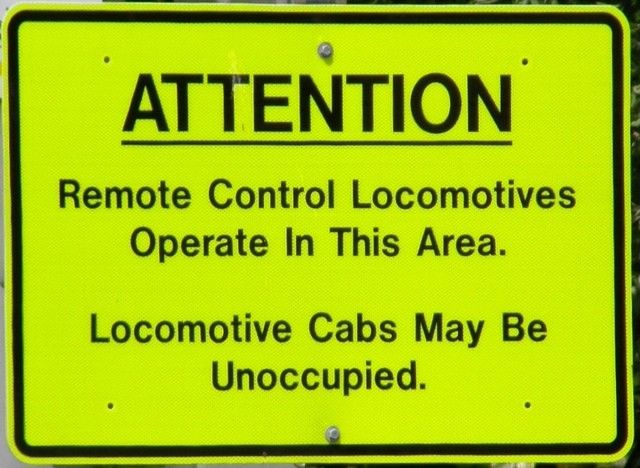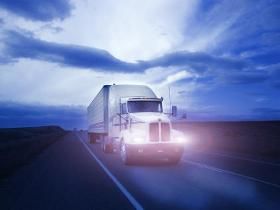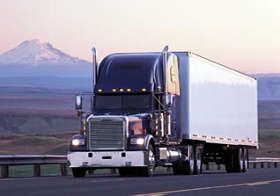Autonomous Trucks - A Response
Topic 19810 | Page 1
The first place we might see actual autonomous transport vehicles is rail, where it makes the most sense and is easiest to set up. But we're not reading those headlines. I wonder why.
"Autonomous" and "automated" are two different things. Automation will continue to find its way into the cab, and in ways that will make hauling freight safer and easier. Autonomy - the ability to make decisions rather than follow programmed configurations - is still way down the road, so to speak.
Good point about rail. I've seen these signs in a number of places:

Note that they are "remotely controlled," not "autonomous." There's still someone making decisions about what the locomotive does.
HOS:
Hours Of Service
HOS refers to the logbook hours of service regulations.My trainer and I were just talking about this yesterday. We had the same thoughts.
About 10 or so years ago Google had the first autonomous car going about 25 mph and only around Silicon Valley. Now that one car travels around the world. But what auto manufacturers took was not "hey we can all make cars drive themselves 10% of the time." They got auto parking control, lane indication, proximity location tech. It's all tech, but still requires someone to operate.
This is what will happen to Trucks as well. There may be One autonomous truck, but it won't be soon or go very far. The rest of the trucks manufactured will get the tech from it to make the driving part of the job safer and easier.

In one of those amazing coincidences, I opened up Patrick Netzel's article on self-driving vehicles just minutes after having a conversation on that very subject with my wife.
I don't see autonomous vehicles "replacing" truck drivers any time soon for a couple of reason.
First, autonomous aircraft have not replaced pilots. Any modern airliner is equipped with a Flight Management Computer and a very complex Automated Flight System. We're talking about vehicles that cost millions, equipped with very sophisticated electronic control systems that make a good part of that cost. And there are still two people up front managing all that stuff. These modern aircraft can do almost everything on their own (and do, because they are efficient.) Once a modern airliner is about 1500 feet off the ground, the Non-Flying Pilot presses a little button called VNAV and then another one called LNAV. From that point on, the airplane climbs to altitude, manages the throttle, turns at waypoints and flies itself to its destination. There is literally nothing the pilots have to do for the plane to get to where it's going. When it gets there, the plane can descend, maneuver into approach and land itself. Once on the ground, the pilot takes over to deploy the reversers, slow the aircraft down and taxi to the gate. (Most pilots turn off the autopilot at around 1000 feet and land the plane themselves, but it *can* land itself and will when visibility mandates a CAT III automatic landing.)
Now, for all of this to work, there still needs to be somebody up front to push all the right buttons on the Control Display Unit to properly program the Flight Management System. But, honestly, that could be handled by any variety of data uplink methods. STILL - there are pilots on board. Why? Because there are people and/or cargo in the back and the Federal Aviation Administration requires that there still be trained pilots to do the one thing all that fancy hardware can't do: make decisions.
And maneuvering an aircraft in open sky is less complex than maneuvering a car in traffic, even if it's the congested skies of the TCA for Newark, La Guardia and JFK.
The feds will continue to require an operator to man the cab of a truck for the same reasons they mandate pilots to sit in the ****pit and engineers to man electric diesels on the railroads: safe interstate commerce. Drivers may very well find themselves migrating into the role of a control operator as cruise control systems get fancier, but they're not going to be removed from the equation.
Secondly, and this is the far more important problem in my book, is the security risk. Smart cars are connected to the Internet of Things. Which means hackers will be salivating to get their mitts on them and make them do stupid things. (Aircraft, oddly enough, are not connected to the Internet in any way that interfaces with their flight control systems. There's a reason for that.) The first time we read headlines about all the smart cars in Detroit suddenly going 90 mph and plowing into traffic, that experiment will be over. And, yeah, I see that happening. It's already part of the conversation in the data security world.
The first place we might see actual autonomous transport vehicles is rail, where it makes the most sense and is easiest to set up. But we're not reading those headlines. I wonder why.
"Autonomous" and "automated" are two different things. Automation will continue to find its way into the cab, and in ways that will make hauling freight safer and easier. Autonomy - the ability to make decisions rather than follow programmed configurations - is still way down the road, so to speak.
In the meantime, autonomous vehicles make for cool headlines and are an interesting project, but they're not a practical solution to commercial freight hauling.
What I would be more inclined to look for is remote control driving via V/R interfacing. Unmanned Commercial Vehicles - controlled by telecommuting drivers sitting in the comfort of their own homes. How about that? And *that* can be done. (But we need a massive data infrastructure upgrade first.)
I'm sorry, but I don't think this is possible. I don't think I've ever seen a smart car do more than 65. ;)
Interstate Commerce:
Commercial trade, business, movement of goods or money, or transportation from one state to another, regulated by the Federal Department Of Transportation (DOT).
Interstate:
Commercial trade, business, movement of goods or money, or transportation from one state to another, regulated by the Federal Department Of Transportation (DOT).
Dm:
Dispatcher, Fleet Manager, Driver Manager
The primary person a driver communicates with at his/her company. A dispatcher can play many roles, depending on the company's structure. Dispatchers may assign freight, file requests for home time, relay messages between the driver and management, inform customer service of any delays, change appointment times, and report information to the load planners.HOS:
Hours Of Service
HOS refers to the logbook hours of service regulations.OWI:
Operating While Intoxicated

I do believe and I may be wrong but they only do that by the rail yards
The first place we might see actual autonomous transport vehicles is rail, where it makes the most sense and is easiest to set up. But we're not reading those headlines. I wonder why.
"Autonomous" and "automated" are two different things. Automation will continue to find its way into the cab, and in ways that will make hauling freight safer and easier. Autonomy - the ability to make decisions rather than follow programmed configurations - is still way down the road, so to speak.
Good point about rail. I've seen these signs in a number of places:
Note that they are "remotely controlled," not "autonomous." There's still someone making decisions about what the locomotive does.
HOS:
Hours Of Service
HOS refers to the logbook hours of service regulations.New Reply:
New! Check out our help videos for a better understanding of our forum features

















Preview:








 TT On Facebook
TT On Facebook
In one of those amazing coincidences, I opened up Patrick Netzel's article on self-driving vehicles just minutes after having a conversation on that very subject with my wife.
I don't see autonomous vehicles "replacing" truck drivers any time soon for a couple of reason.
First, autonomous aircraft have not replaced pilots. Any modern airliner is equipped with a Flight Management Computer and a very complex Automated Flight System. We're talking about vehicles that cost millions, equipped with very sophisticated electronic control systems that make a good part of that cost. And there are still two people up front managing all that stuff. These modern aircraft can do almost everything on their own (and do, because they are efficient.) Once a modern airliner is about 1500 feet off the ground, the Non-Flying Pilot presses a little button called VNAV and then another one called LNAV. From that point on, the airplane climbs to altitude, manages the throttle, turns at waypoints and flies itself to its destination. There is literally nothing the pilots have to do for the plane to get to where it's going. When it gets there, the plane can descend, maneuver into approach and land itself. Once on the ground, the pilot takes over to deploy the reversers, slow the aircraft down and taxi to the gate. (Most pilots turn off the autopilot at around 1000 feet and land the plane themselves, but it *can* land itself and will when visibility mandates a CAT III automatic landing.)
Now, for all of this to work, there still needs to be somebody up front to push all the right buttons on the Control Display Unit to properly program the Flight Management System. But, honestly, that could be handled by any variety of data uplink methods. STILL - there are pilots on board. Why? Because there are people and/or cargo in the back and the Federal Aviation Administration requires that there still be trained pilots to do the one thing all that fancy hardware can't do: make decisions.
And maneuvering an aircraft in open sky is less complex than maneuvering a car in traffic, even if it's the congested skies of the TCA for Newark, La Guardia and JFK.
The feds will continue to require an operator to man the cab of a truck for the same reasons they mandate pilots to sit in the ****pit and engineers to man electric diesels on the railroads: safe interstate commerce. Drivers may very well find themselves migrating into the role of a control operator as cruise control systems get fancier, but they're not going to be removed from the equation.
Secondly, and this is the far more important problem in my book, is the security risk. Smart cars are connected to the Internet of Things. Which means hackers will be salivating to get their mitts on them and make them do stupid things. (Aircraft, oddly enough, are not connected to the Internet in any way that interfaces with their flight control systems. There's a reason for that.) The first time we read headlines about all the smart cars in Detroit suddenly going 90 mph and plowing into traffic, that experiment will be over. And, yeah, I see that happening. It's already part of the conversation in the data security world.
The first place we might see actual autonomous transport vehicles is rail, where it makes the most sense and is easiest to set up. But we're not reading those headlines. I wonder why.
"Autonomous" and "automated" are two different things. Automation will continue to find its way into the cab, and in ways that will make hauling freight safer and easier. Autonomy - the ability to make decisions rather than follow programmed configurations - is still way down the road, so to speak.
In the meantime, autonomous vehicles make for cool headlines and are an interesting project, but they're not a practical solution to commercial freight hauling.
What I would be more inclined to look for is remote control driving via V/R interfacing. Unmanned Commercial Vehicles - controlled by telecommuting drivers sitting in the comfort of their own homes. How about that? And *that* can be done. (But we need a massive data infrastructure upgrade first.)
Interstate Commerce:
Commercial trade, business, movement of goods or money, or transportation from one state to another, regulated by the Federal Department Of Transportation (DOT).
Interstate:
Commercial trade, business, movement of goods or money, or transportation from one state to another, regulated by the Federal Department Of Transportation (DOT).
Dm:
Dispatcher, Fleet Manager, Driver Manager
The primary person a driver communicates with at his/her company. A dispatcher can play many roles, depending on the company's structure. Dispatchers may assign freight, file requests for home time, relay messages between the driver and management, inform customer service of any delays, change appointment times, and report information to the load planners.HOS:
Hours Of Service
HOS refers to the logbook hours of service regulations.OWI:
Operating While Intoxicated